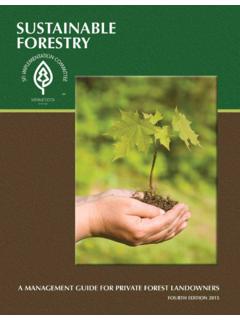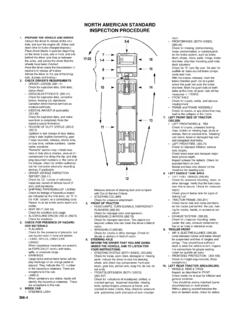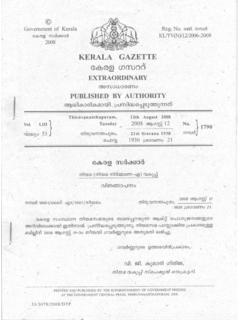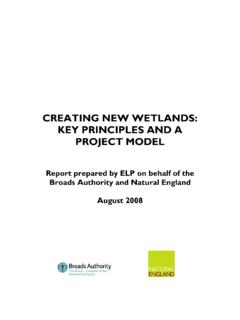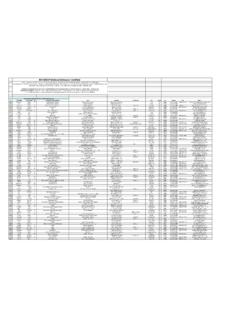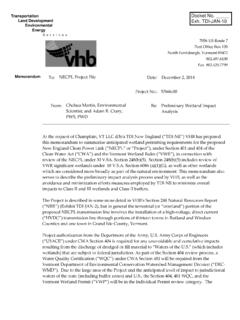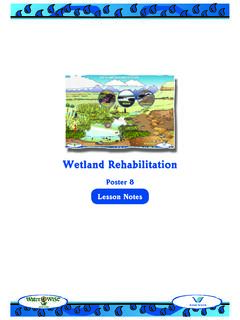Transcription of Temporary Stream, Wetland & Soft Soil Crossings
1 Temporary Stream, Wetland & soft soil Crossings Minnesota Erosion Control Association Temporary Stream, Wetland & soft soil Crossings Prepared by Carolyn Dindorf and Kseniya Voznyuk, Minnesota Erosion Control Association 215 Hamel Road Hamel, MN 55340 assistance from: Rick Dahlman, Mn Department of Natural Resources Charlie Blinn, University of Minnesota Dwayne Stenlund, Mn Department of Transportation Dave Chura, Minnesota Logger Education Program Dan Steward, Board of Water and soil Resources Cover Photos: MECA and MNDNR Photo and Illustration credits are noted on each photo or illustration. If not indicated, photos and illustrations were provided by the Minnesota Erosion Control Association. Thank you to all who provided photos for this publication. This project was funded in part by the Coastal Zone Management Act, NOAA s Office of Ocean and Coastal Resources Management, in cooperation with Minnesota's Lake Superior Coastal Program December 2009 (Revision 1, February 2010)2 TABLE OF CONTENTS Table of The Importance of Evaluating the Sources of Planning Best Management Temporary Stream crossing Temporary Timber/log Lumber Stress-Laminated Other bridge Ice Cable concrete Pipe Temporary soft soil or Wetland crossing Corduroy/slash Plastic 3 Wood Wood Mats, panels & Ice Other Plastic Ditch Portable Mat Additional Minimize soil Movement and Landing/staging area tracking Erosion and Sediment Erosion Sediment Removing Materials and Restoring Closing Material References and Appendix A.
2 INTRODUCTION The purpose of this publication is to provide basic information on Temporary stream, Wetland and soft soil Crossings in order to minimize impacts to water resources while providing stable access across them. The target audience is loggers, construction contractors and resource managers. Many of the practices covered in this publication can be constructed from materials available on site, recycled materials, or may be borrowed or rented. Most of these practices are low cost and reusable. Poor logging and construction practices can increase sediment and other pollutants generated during storms. Douglass and Swank (1975) found an increase of 10 to 20 times more sediment generated from a poorly logged area versus an undisturbed area. A Wisconsin study found that sediment loads from two small construction sites were 10 times larger than typical loads from rural and urban land uses (USGS, 2000). Use of the practices recommended in this booklet can help minimize impacts to public water resources, help meet regulatory requirements, and help keep your operations productive.
3 PLANNING THE IMPORTANCE OF PLANNING Planning should be the first step in any successful project. With proper planning, many potential problems can be avoided and the project can proceed more efficiently. When dealing with wetlands, lakes and streams, several local, state and federal regulations must be followed. Many projects that impact surface waters require a permit. It may take two to three months or longer to obtain a permit. Planning can help you avoid costly delays and keep your operations productive. For example, identifying and avoiding soft soils means you won t have to spend a lot of time pulling equipment out of the mud. 5 If you are doing any work that affects a stream channel, you may need a permit. Check with the Department of Natural Resources (MNDNR) and other agencies (see Appendix A for more information). There are federal, state and local regulations to prevent draining, filling and excavation of wetlands. Determination of a Wetland boundary is not as simple as it may seem.
4 There is a legal definition of a Wetland that may not match what the lay person thinks is a Wetland . Wetland delineation may be required in some cases. The length of the crossing may be longer than expected based on the legal Wetland boundary. Some agencies' regulations include exemptions for certain roads that meet specific conditions. Check with each agency to learn if any exemptions might apply to your project (see Appendix A). The Minnesota Wetland Conservation Act (WCA), the Minnesota Pollution Control Agency (MPCA) Water Quality Standards (MN Rule 7050) and the Army Corps of Engineers rules (Section 404) require a sequencing process for projects impacting wetlands. This includes 1) avoiding impacts, 2) minimizing impacts, and 3) mitigating impacts. Scouting the site for the crossing location with the least impact to a watercourse or Wetland is recommended and should save time and money. Planning the layout of the Temporary road can help you minimize impacts due to erosion.
5 Look for gradual grades and areas where soil movement can be minimized. Part of the planning should include an evaluation of the best time of year to complete the project that would minimize impacts on the resources. Projects that can be completed during the winter months when soils and small streams are frozen can greatly minimize impacts. Spring conditions with high water and wetter soils should be avoided if possible. Waters designated by the MPCA as Outstanding Resource Value Waters (ORVW), trout waters, or impaired (303d-listed) waters may require additional or advanced best management practices (BMPs) in order to protect them from impacts. For streams, depending upon the fish species present, different times of the year are better than others (refer to the 6 MNDNR Publication Best Practices for Meeting DNR General Waters Work Permit GP2004-0001 for specific information). For most projects, reducing the amount of time the site is under construction and soil is exposed is one of the best practices to minimize environmental impacts.
6 Following BMPs is not only beneficial for the environment; it also will be beneficial for the overall project in terms of minimizing soil movement and repairing areas. This will also save money. EVALUATING THE SITE Site evaluation leads to more efficient implementation and avoidance of problems. Scout the site to identify any special areas or features. Your site plan should include a sketch as well as a narrative of the proposed work, the order the operations will occur and how the site will be stabilized. Complete a sketch of the site to identify important features and the work areas. The sketch should include natural features such as streams, wetlands, ponds, rare plants, and steep slopes. The sketch should also include the layout of your operations, including Temporary roads, access from public roads, concentrated work equipment activity area such as staging areas or log landings, stream or Wetland Crossings , landing or staging area, and location of spill kit and refueling and maintenance area, and portable toilet.
7 Erosion and sediment control practices should also be noted. The example site plan on the next page shows many of the practices discussed in this booklet that could possibly be used on a site. The different BMPs should be used where appropriate depending on the specific site conditions and type and extent of disturbance. For example, a construction site which has greater soil disturbance will require more BMPs than a timber harvest area, where the soil is not disturbed to the same extent. Your plan should include avoiding disturbance of, Steep slopes Archeological sites- contact the State Historic Preservation Office Dumps and areas of contaminated soils Erodible soils 7 soft soils Public waters- contact the area MNDNR office for a map of public waters ORVW, trout waters and impaired waters check the MPCA web site for map searching tools at Ecologically sensitive resources-Minnesota's rare plants and animals, native plant communities, and other rare features (contact the MNDNR Natural Heritage Program at to request a search)
8 BufferBuffer BufferStream Wetland Timber Area Timber Area Timber Area Old homestead Bridge Contours/flow Special plants Tree/slash perimeter County Road Site Plan- overlayed on a USGS Quad map Ditch Ditch check Haul Road Landing TolietspillkitslashmulchSlash berm Straw bales or silt fence Wood mats & Corduroy BMPs Slash mulch entrance Slash mulch berm Bales or silt fence at Crossings Bale ditch checks Water bars Temporary timber bridge Pipe bundles for bridge approaches Vegetated buffers Mats or panels over shallow Wetland area Corduroy at Wetland approach Seed and mulch WorkareaWork AreaWork Area Water bars Landing or staging area 8 9 If you are unable to avoid crossing a stream or Wetland , walking the site and creating a sketch will help you identify the best place for placing the crossing to minimize impacts on the waters and other important features. Choose a road access area that will help facilitate closing after work is completed. To increase the effectiveness of the closure, select an area that will be easy to close afterward, due to terrain, water, rocks, or trees.
9 The entrance should be curved to limit the view into the forest or other area. An effective closure will help minimize unwanted vehicle access in the future. How much weight can the ground handle? Use the following table to help you estimate soil strengths using this simple penetration test. It is a rough estimate of a measurement known as the California Bearing Ratio (CBR), developed by the California Department of Transportation. Estimated Consistency by: Feel Sight CBR% Water Person is wet 0 Very soft Person standing sinks more than 3 inches < soft Person walking sinks about 2 to 3 inches Medium Person walking sinks about 1 inch Stiff Pickup truck ruts about to 1 inch Very Stiff Loaded dump truck ruts 1 to 3 inches Hard Insignificant ruts from loaded dump truck > Source: MN/DOT, 2007 10 Here s another simple measurement device to help you estimate what load your soils can handle. Construct this simple tool using a -in.
10 Diameter steel rod 2 feet long with a T handle. Mark the rod at 6-in. increments from the bottom. Push the T-rod into the ground where you plan to drive. If the rod goes in the ground 6-in., you may not need mats (or other options); 12-in., the tires will leave a 2-in. to 3-in. mark; 18-in., you re going to get stuck; 24 in., the truck is going to the frame right ( ). SOURCES OF PLANNING INFORMATION Depending on the type of project, there are several sources of information that can help you plan and prepare for projects that may impact wetlands, streams and other natural resources. More information on regulatory requirements and contacts is found in Appendix A. Minnesota Logger Education Program (MLEP) - periodically holds workshops on planning road layout and other topics for loggers. Minnesota Department of Natural Resources Forestry - can provide assistance to loggers with minimizing impacts and permit needs. Waters - A DNR public waters work permit (application available under ) may be required for work in streams, lakeshores and public water wetlands.


